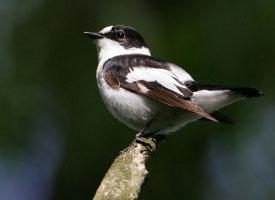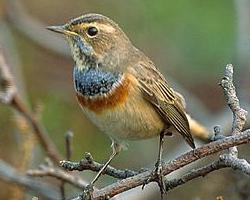
Description de l'animal
The Collared Flycatcher (Ficedula albicollis) is a small, strikingly marked passerine bird that belongs to the Old World flycatcher family, Muscicapidae. This species exhibits a remarkable blend of elegance and agility, which is beautifully encapsulated in its appearance and behavior. The Collared Flycatcher is widely appreciated not only for its aesthetic appeal but also for its fascinating ecological role and intriguing life history.Adult males of the species are particularly eye-catching during the breeding season, with their predominantly black and white plumage. They display a glossy black head, back, and wings that contrast sharply with a vivid white underbelly. A defining feature is the prominent white collar around the neck, from which the species derives its common name. This collar is complemented by a pair of white patches on the wings, which are particularly conspicuous in flight. The male's tail is black with white sides, and his beak is dark, contributing to his striking appearance. Outside of the breeding season, the male's plumage becomes somewhat less contrasting, with feathers taking on a more muted tone.
Females and juveniles, on the other hand, are more subdued in coloration, featuring a palette of browns and whites. They possess a brownish back, wings, and tail, while the underparts are off-white with a hint of brown. The distinctive white collar seen in males is either absent or only faintly indicated in females, making them less conspicuous but equally elegant.
Collared Flycatchers are small birds, typically measuring around 12 to 13.5 centimeters in length, with a wingspan of approximately 22 to 26 centimeters. Their small size and agile flight make them adept at catching insects mid-air, which constitutes the majority of their diet. They are also known to feed on spiders and caterpillars, gleaning them from leaves and branches in their woodland habitats.
The natural range of the Collared Flycatcher primarily extends across central and eastern Europe, with some populations found in western Asia. They are migratory birds, spending the winter months in sub-Saharan Africa, where they enjoy a variety of wooded habitats. During the breeding season, they prefer deciduous forests and woodland edges, where they can find suitable nesting sites in tree cavities or old woodpecker holes.
The breeding season unveils another layer of the Collared Flycatcher's intriguing behavior. Males are known for their melodious songs, which they use to attract mates and defend their territories. Once paired, the female takes on the task of building the nest, using moss, grass, and feathers to create a soft lining within the chosen cavity. She then lays a clutch of 4 to 7 eggs, which she incubates for about two weeks. Both parents are involved in feeding the chicks, which fledge approximately two weeks after hatching.
The Collared Flycatcher plays a vital role in its ecosystem as a control agent for insect populations. Furthermore, its preference for nesting in natural cavities makes it a valuable indicator species for the health of old-growth forests.
Despite facing challenges such as habitat loss and climate change, the Collared Flycatcher remains a species of least concern according to the International Union for Conservation of Nature (IUCN), thanks to its wide range and relatively stable population. Conservation efforts continue to ensure that this enchanting bird remains a vibrant part of its natural habitats for generations to come.
Animaux similaires
Nouvelles photos d'animaux
Top 10 des animaux
- Dolphin gull (Leucophaeus scoresbii)
- Diana monkey (Cercopithecus diana)
- Moustached guenon (Cercopithecus cephus)
- Galápagos tortoise (Geochelone nigra complex)
- Japanese macaque (Macaca fuscata)
- Russian tortoise (Testudo horsfieldii)
- Stone loach (Barbatula barbatula)
- Greek tortoise (Testudo graeca)
- Common flying dragon (Draco volans)
- Vendace (Coregonus albula)


